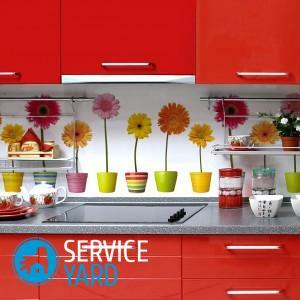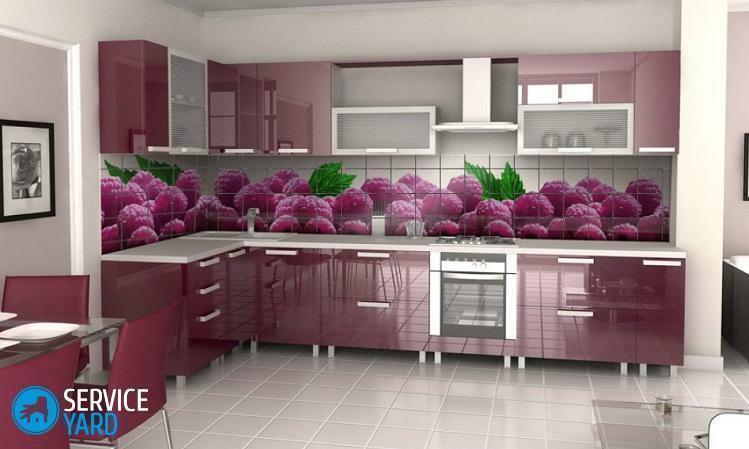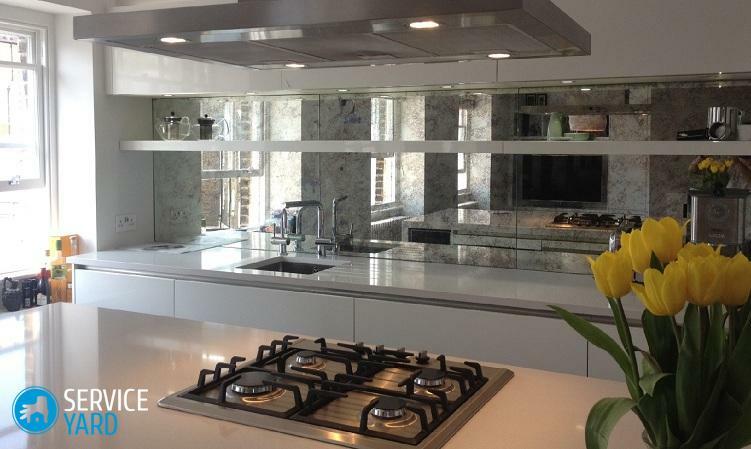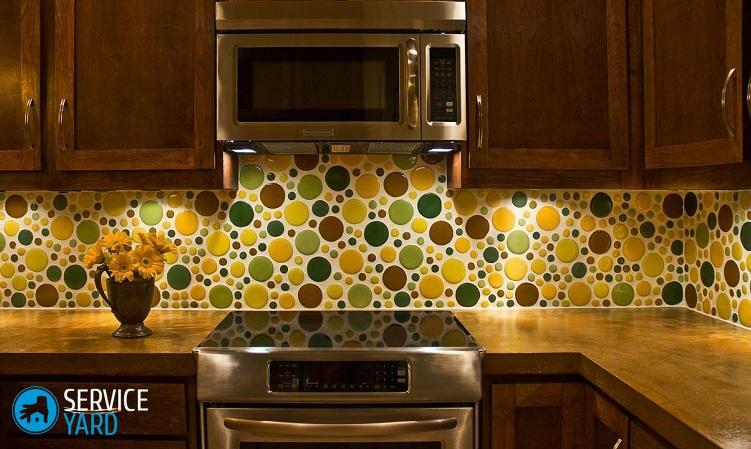
- Why do I need an apron in the kitchen?
- Finishing requirements: how to choose a practical and beautiful kitchen apron?
- Variety of kitchen aprons
- Color solution for kitchen apron
How to protect the walls in the kitchen from various contaminants and at the same time create a unique interior? With this task, the kitchen apron perfectly manages. In the work area, it is simply necessary! If you approach the design with a good sense of alignment, you can not imagine what an incredible effect can be achieved. So let's take a closer look at how the apron in the kitchen is best chosen, what can it be made of?
to the contents ↑Why do I need an apron in the kitchen?
Kitchen apron is a part of the wall, located between pendant lockers and a table top, and also near the stove. This decoration fringes the working area, in which the housewives are engaged in direct cooking. The purpose of this coating is to protect the wall from a variety of contaminants, the traces of which are sometimes difficult to remove.
Important! The wallpaper or stucco is not intended for a kitchen apron, as soot, fat, various smells are easily eaten in these finishes.
The surface of the kitchen apron should be the most suitable for the kitchen conditions that come from its purpose. In addition, finishing the working area is an excellent field for design solutions, ideas that can transform a room, make it unique. Cooking food in a beautiful, stylish environment will be very nice to any hostess.
to the contents ↑Finishing requirements: how to choose a practical and beautiful kitchen apron?
Which apron in the kitchen is better to choose - will be able to suggest the criteria that it must comply with. In addition to its aesthetic, interior function in the room, the apron must cope with the practical role, and therefore - be useful.
We list the main requirements for this kitchen finish:
- Resistance to different temperature conditions. Differences can be quite noticeable. So, the wall near the slab is exposed to high temperatures as a result of heating. And in the area near the sink, for example, there is a lower temperature due to the use of cold water.
- Water resistance. Another important point, since the kitchen is always an increased level of humidity. Steam, the constant use of cold, hot water exert a strong influence on the finishing materials.
- Uncomplicated care, cleaning. The cooking process is regular and daily, so the surface of the kitchen apron is quickly soiled. In order not to increase the time spent in the kitchen due to long cleaning, the materials should be easy to wash and clean.
- Hygiene. In conditions of high humidity, temperature extremes, it is necessary to avoid the appearance and reproduction of bacteria and fungi. Therefore, the materials of decoration must be of high quality and be hygienic.
- Resistance to mechanical damage. Systematic cleaning of the kitchen apron should not spoil or scratch its surface. In addition, the kitchen uses a large number of small household appliances, sharp and cutting objects, contact with the wall should not leave a trace.
- Harmonious design. The decoration should be in tune with the general interior of the kitchen, combined with furniture, textiles. The stylish decor will make the room beautiful and spectacular.
Having considered the important requirements for this coating, let's find out what is better to make an apron in the kitchen, what are the pros and cons of this or that material.
to the table of contents ↑Variety of kitchen aprons
A variety of materials are used to finish the wall in the work area, which allows choosing the most suitable option based on the desired result and monetary possibilities. Manufacturers offer both traditional building materials, and rather innovative and non-standard solutions. For example, bamboo plugs. How to choose an apron for the kitchen and what sorts of them can be distinguished?
Ceramic tiles
This is the most popular finishing material of the kitchen apron. What is the reason for this prevalence in the application? Explained by a huge number of advantages:
- High hygienic tiles. There are practically no pores in it, so that harmful bacteria and fungi can not reproduce.
- Water resistance and heat resistance. Steam, water - are not terrible for ceramic finishing. And it is fire resistant, which is important in an open fire near a gas stove.
- Easy care. Fat and dirt are not absorbed into the ceramic surface, and are simply removed with a sponge. You can not be afraid and use a variety of detergents.
- Durable material with a long service life. The tile is very difficult to spoil, it almost does not scratch and does not lend itself to mechanical damage.
- Variety of styles and types of this building material. You can easily select pottery for the design of your kitchen - from the sophisticated Vintage style to the cutting-edge high-tech.
- The color scheme is also not inferior in a variety of options. Tiles can be decorated with beautiful ornaments and drawings on the kitchen theme, or have a neutral execution.
- Texture can be smooth and glossy, or have a matte surface and roughness. Pottery is able to perfectly imitate a natural stone or wood.
- The tile has an affordable price and its wide range. Thus, you can purchase a tile commensurate with your budget.
Important! Specialists in the field of design recommend choosing a small tile, for example, 8x8 or "bricks" 5x10, or 5x15 cm.

Ceramic lining allows you to diversify and decorate the interior of the kitchen. On the perimeter of the apron you can install a decorative frieze - these are narrow strips of tile, complementing the composition of the finish. This solution allows you to visually expand the plane of the apron, and the contrast will add volume.
The work surface area is small, and you can afford to use more expensive materials and design ideas. Manufacturers are ready to offer a variety of tile panels, rosettes, combined ideas, imitation of natural materials, etc.
Important! The use of ceramic tiles allows you to give the interior an original image due to the very method of laying.
There are also drawbacks, however, there are very few of them:
- Before the lining, the surface of the walls must be carefully leveled and prepared.
- The installation of ceramics is a rather complex process, and it will be best entrusted to a specialist in this field.
- Presence of inter-tile joints, which can be susceptible to accumulation of dirt and harmful microbes. However, this issue can be solved by the selection of a high-quality moisture-resistant grout.
Mosaic - a stylish version of
What apron is best done in the kitchen? A very effective and original way of decorating the working area is a mosaic. The beauty and incredibility of the design will make your kitchen truly superb.
In addition to its beautiful aesthetic appearance, the mosaic has several advantages:
- Hygienic material.
- Water resistance, heat resistance and wear resistance. These indices are no worse than ceramics or porcelain stoneware.
- Design. A huge range and variations of the mosaic pattern. Possibility to lay out the most unimaginable patterns, ornaments and drawings. Create a whole composition from pieces.
Important! Fine mosaic elements can be made of ceramics, glass, metal or mirrors. The most recommended size of tiles: 5x5 or 7x7 cm.
Glass mosaic is best combined with kitchens in a modern style, and for matt facades or "wooded" - recommend ceramic.
What are the disadvantages of this method of finishing the kitchen apron?
- Expensive finishing material.
- The laborious and laborious installation. Styling the mosaic is a very delicate process. To work was done qualitatively, only professional services will be required, which is also quite expensive.
- Care. Since the mosaic consists of many small tiles, this will entail a large number of docking seams. This complicates the care of the surface.
Important! Professionals advise to process the seams with a sealant, and also periodically update the grout.
Currently, there is an alternative to single mosaic masonry, manufacturers offer ready-made sheets of various sizes. They are easy to cut to give the required size, and to the wall they are attached using a special solution.
MDF panels
How to choose the apron to the kitchen set most suitable? Here the best assistant will be panels from MDF.
Important! MDF is a fibreboard, characterized by an average density of 4-10 mm thick. Its surface is covered with a matte furniture film, and as most often such panels are produced by manufacturers of kitchen countertops, this material is perfectly combined with furniture.
Due to the MDF panels, the effect of a single holistic coating is achieved. The table top moves smoothly into the wall, and due to the profile for the corners this transition is barely noticeable, since it is installed between them and is decorated in the same style.
What are the advantages of using such panels?
- Low price.
- Easy installation. The panel is attached to the wall using liquid nails or metal staples. Since the process is fairly simple, these panels can be easily dismantled if necessary.
- No tile joints, like ceramic or mosaic, which does not require special care. Easy to clean.
- Do not require a perfectly flat surface of the wall - on the contrary, contribute to concealing shortcomings.
- Water resistant material, resistant to different temperatures.
- Durable to mechanical damage.
Let's designate some minuses of this design of a kitchen apron:
- Short-lived material with a short service life.
- It is not recommended to use such panels near open flames, since it is possible to ignite the material. Especially this applies to the area near the gas stove.
- Limited range. The style of these panels is rather narrow and differs in its simplicity. Most often, manufacturers mimic marble and granite, much less often a tree or bamboo.

Plastic panels
You can also choose an apron for the kitchen from plastic panels. They began to be in demand due to their budget and easy installation with profiles.
What properties this finishing material has:
- The smooth surface is elementary in care and cleaning.
- Very inexpensive material, has various color solutions and ornaments.
- Simple installation, which can be done by yourself.
But the disadvantages of plastic panels:
- Under the influence of sunlight can turn yellow, getting fat also contributes to the deterioration of appearance.
- It is deformed from the heat, which categorically does not allow the possibility of their installation near the gas stove.
- Reacts to dampness and changes in volume, so part of the working area of the sink is also unfavorable for plastic panels.
Important! If you decide to make a kitchen apron with plastic panels, choose a transparent material that is made of polycarbonate and acrylic. Also, such finishing is most suitable for a kitchen with an electric stove or induction.
Panels from glass
If you still have not decided what better to make an apron in the kitchen, this option will be win-win. Glass panels - practical and very stylish design of the working area.
Important! Panels are produced not from ordinary glass, but from special impact-resistant and hardened material.
Let's turn to the advantages of such finishing:
- High level of moisture resistance and heat resistance. Panels are not afraid of heat and water - boldly install them near the stove or sink.
- No seams.
- Hygienic material. Does not absorb moisture, smells, dirt. It is easy to clean.
Important! When cleaning glass surfaces, do not use abrasive detergents to avoid scratching them.
- Incredible design delights and solutions. Glass - a multifaceted material for the most incredible and exclusive ideas in the interior of the kitchen. It can be transparent or colored, glossy or matte, smooth or corrugated. For registration, you can use any kind of ornaments, drawings and even photo prints.
Making a wall using a photo is very fashionable and unusual. There are two ways to do this:
- A photo panel is placed between two glass sheets.
- Photo printing on top of the glass.
This panel looks amazing! You can display on the panel all that you want, limited only by your imagination and financial capabilities.
Important! The installation is only necessary with the help of specialists, since the installation is complicated by the weight of a single piece of glass.
The disadvantages of this finish are the whole pair:
- High price. Individual approach is always an expensive pleasure. And glass panels are made only to order, using special technologies, strictly according to the individual parameters of the kitchen.
- The need for careful polishing of the glass surface.

Natural and artificial stone
What apron is best done in the kitchen, if you want to give the room solidity and presentability? Of course, a natural stone or its artificial analog will make the room luxurious, especially if your kitchen is large in size.
The choice is limited to several types of finishes:
- Porcelain. High-quality material, not affected by water, temperature, has a high degree of hygiene. Particularly strong and durable facing.
- Clinker tiles are stylized for brickwork. Ideally combined with an interior in the style of Loft or Country.
- Marble is characterized by an increased porosity of the material, which in the kitchen conditions results in appreciable moisture, low hygienic and dirt absorption.
- Basalt and granite. Quite practical materials, but require careful treatment with special means, since they absorb the pigmentation pigments.
Regardless of the material selected, the natural finish has a number of advantages:
- Strength, moisture resistance and heat resistance.
- Long service life.
- Effectively combined with a table top in the style of natural stone.
- A small number of joints.
- A wide range of colors and textures of the material. You can choose from marble, granite, onyx, malachite.
And the disadvantages are:
- High price, because such a finish is made only for individual order.
- A stone is a very complex material. Correct the size is difficult enough, the plates do not lend themselves to repair, and installation is a laborious and expensive process. Only qualified specialists can install.
- Heavy weight, so you need to determine in advance the permissible load on the walls.
Important! The artificial finish differs from the natural at a lower price, but is not inferior to the performance characteristics and external aesthetic appearance.
Aprons made of steel
What kind of apron in the kitchen is better to choose if the furnishings and the interior of the room are sustained in the modern style of High-tech, Minimalism or Techno? To use it as much as possible to emphasize this design, use an apron made of metal. Suitable materials such as copper, brass, steel or stainless steel.
Important! The options for using steel in the design are different - it can be solid sheets, tiles, there is even a mosaic.
Pros of this kitchen apron:
- Relatively low price.
- Simple installation.
- Excellent performance: water resistant, durable, not subject to temperature, absolutely hygienic.
- Durability.
- Original appearance.
Important! But the only drawback of the steel surface is cleaning and caring for it. Various impurities and stains instantly become noticeable, therefore it is necessary to wash the coating carefully with the help of special equipment and always wipe dry with a soft cloth.
to the table of contents ↑Color solution for the kitchen apron
When choosing the color for the decoration of the kitchen apron, follow these simple rules:
- The wall tint should perfectly blend in with the overall interior.
- Follow your taste and pay attention to the overall organization of the space.
Color solutions in the interior are always possible in several variants: contrast or consonance of color gamut, horizontal boundaries.
Contrast
Especially good play on contrast in the kitchen, decorated in the style of High-tech, Avant-garde and Minimalism. Choose the brightest color in relation to the facade of kitchen furniture. For example: a white set - a red apron, blue and white, etc. This creates a bright accent, attracts attention and makes the interior much more colorful.
Important! Add a bright kitchen apron with additional decor elements of the same color. Various vases, utensils and kitchen utensils give the kitchen a more complete look.
Solid interior
In this situation, the tone of the apron is selected to the color of the furniture. Thus, the monochrome design of the kitchen is obtained. The color of the apron is recommended to be made in one color if you want to make an interior of a neutral pastel color: light beige, cream, light gray, etc.
Important! Combine kitchen furniture and walls, which are different in color, you can use an apron. It is necessary to decorate it in the tone of the wallpaper.
Horizontal border
The original way to give the room a kind of look, and at the same time and visually increase the space. The method of such design is to clearly delineate the bottom of the furniture set, apron and top, lockers. The color solution can be performed in shades of the same color, or in a contrast combination of tones. As a result, smooth horizontal lines are obtained, which gives the interior an effect and individuality.
We have considered in detail how to choose a kitchen apron, on which it is necessary to sharpen attention and what fashion trends exist in modern design. With this information, you can easily create an original and stylish surface in the kitchen in the work area, which will please you with its practicality and pleasant design.
